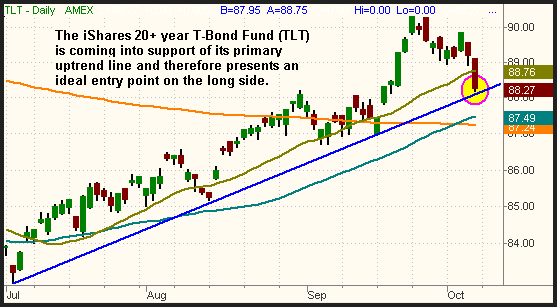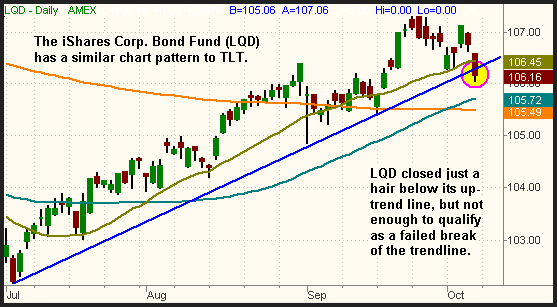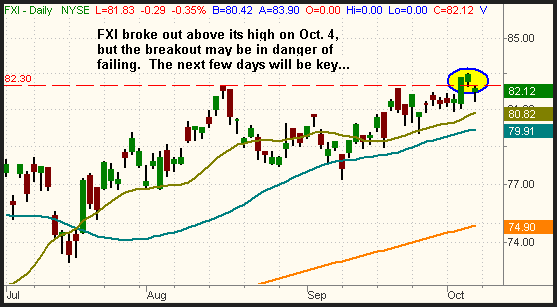The broad market gapped down last Friday morning, but subsequently traded in a narrow, sideways range throughout the session. The major indices finished the day lower, but their losses were minimal considering the recent gains. Both the S&P 500 and Nasdaq Composite slipped 0.3%, while the Dow Jones Industrial Average held near its all-time high by losing only 0.1%. The small-cap Russell 2000 fell 0.4%, while the S&P Midcap 400 declined 0.6%. All the indices finished near the middle of their tight intraday ranges, indicating a bit of indecision into the close. Nevertheless, the stock market logged impressive gains for the week. The S&P 500 rallied 1% and broke out to a new five-year high in the process. The Dow cruised 1.5% higher and, as you've surely heard numerous times over the past several days, moved to a fresh record high. The Nasdaq Composite still remains below even its 52-week high, but advanced 1.8% last week.
Although stocks closed lower across the board, it's positive that they did so on lower turnover. Total volume in the NYSE declined by 9%, while volume in the Nasdaq was 14% below the previous day's level. In strong markets, most of the "down" days should occur on lighter volume, as it indicates the bears are not taking control when the bulls are taking a rest. Not surprisingly, market internals were negative by only a relatively small margin as well. In both the NYSE and Nasdaq, declining volume exceeded advancing volume by a ratio of just under 2 to 1. The broad market's insubstantial percentage losses, combined with the lighter overall volume levels and moderate market internals, indicates that Friday's action was merely a healthy price correction within the context of a solid uptrend.
If you're looking for a new long setup that may not be so "obvious" to the crowd, consider the iShares family of fixed-income funds, most of which are approaching low-risk entry points on the buy side. Each of these bond ETFs have been in steady uptrends since the beginning of July 2006, which we pointed out several times along the way, but they are finally in the process of correcting down to support of their primary trendlines. Below is a daily chart of the iShares 20+ year Treasury Bond Fund (TLT). The ascending blue line illustrates support of the multi-month uptrend, a retracement to which would present an ideal buying point. A protective stop on such an entry should not be much below the 50-day moving average (the teal line):

Most of the ETFs in the fixed-income family have similar chart patterns. This is important because we always like to have confirmation of similar chart patterns within the same sector. If, for example, TLT was the only bond ETF that was in an uptrend, we would pass it by because stocks and ETFs without sector confirmation usually have a difficult time sustaining a trend. Notice how the iShares Corporate Bond Fund (LQD) has been moving nearly in lockstep with TLT:

Of the six different iShares bond ETFs, the only one we would avoid is the TIPS Bond Fund (TIP). It has been showing a lot of relative weakness while the others have been moving higher, and is the only ETF in the family that is still below its 200-day moving average. Like all ETFs, remember that the fixed-income ETFs pay dividends whenever the underlying issues do so. In the case of the iShares bond ETFs, each of them pay dividends on a monthly basis, a nice bonus in addition to any capital gains you may realize.
Last week, we pointed out the potential breakout that was setting up in the iShares Xinhua China 25 (FXI). As you may recall, we were anticipating a breakout above the high of a tight consolidation at its 52-week high. On October 4, the breakout came, but FXI fell back down to its breakout level two days later. As such, it is now at a "make it or break it" level:

Being that it only closed last week a few cents below the high of the prior consolidation, it could still easily hold and take off from here. It therefore provides a great risk/reward level for entry on the long side, just as long as you keep a tight stop below the October 4 low, which nearly converges with the 20-day moving average as well. Conversely, we also know that failed breakouts to new 52-week highs make very nice short selling opportunities as well. We'll be monitoring the price action in FXI closely over the next several days and may take a position. As always, regular subscribers will be notified via e-mail alert of any intraday entries.
Deron Wagner is the Founder and Head Trader of both Morpheus Capital LP, a U.S. hedge fund, and Morpheus Trading Group, a trader education firm launched in 2001 that provides daily technical analysis of the leading ETFs and stocks. For a free trial to the full version of The Wagner Daily or to learn about Wagner's other services, visit MorpheusTrading.com or send an e-mail to deron@morpheustrading.com.